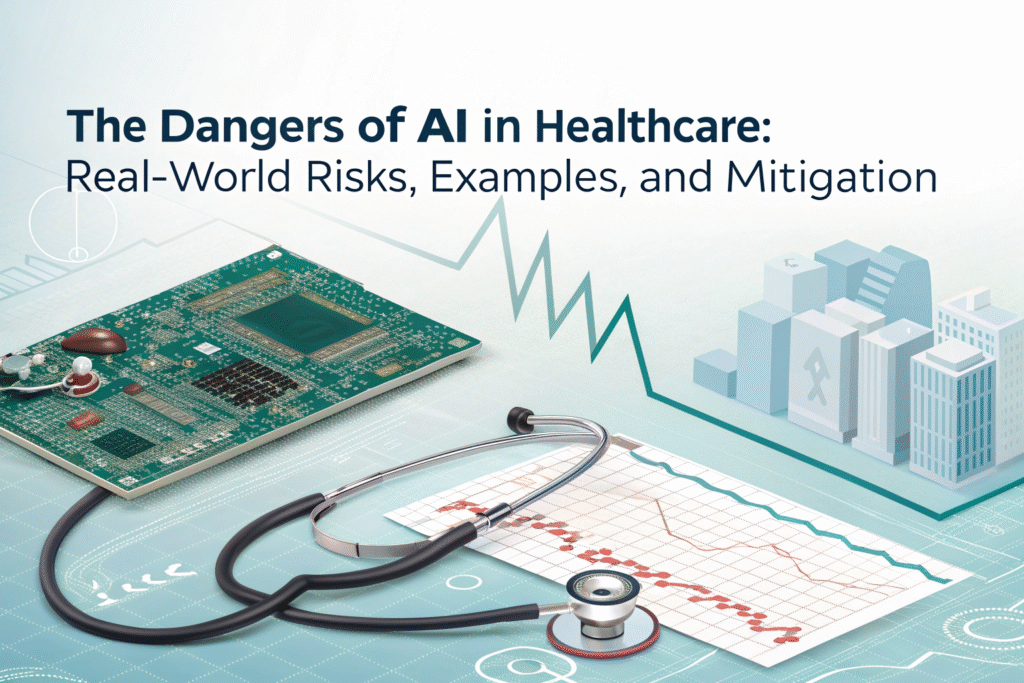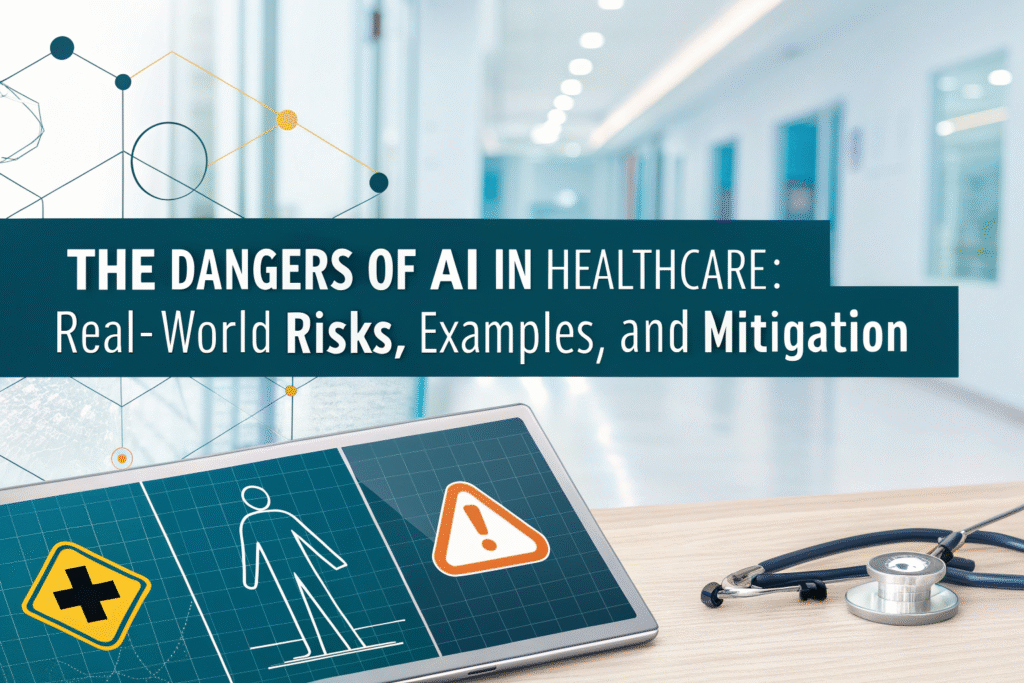
Introduction
Artificial Intelligence (AI) is no longer a futuristic concept in healthcare; it is a present-day reality driving a paradigm shift. From diagnosing diseases with superhuman accuracy in medical imaging to predicting patient outcomes and personalizing treatment plans, AI’s potential to enhance efficiency, reduce costs, and save lives is immense. Algorithms are being deployed to streamline administrative tasks, manage hospital workflows, and even power the next generation of robotic surgery. However, this rapid and powerful integration comes with a shadow side. The very capabilities that make AI transformative also introduce profound and complex risks. For entrepreneurs, developers, and healthcare leaders, ignoring these risks is not an option. A thorough understanding of the dangers of artificial intelligence AI in healthcare examples is crucial for building ethical, effective, and trustworthy solutions. This article provides a comprehensive examination of these pitfalls, illustrated with real-world cases, and offers a strategic roadmap for responsible innovation.
The Accelerated Evolution of AI in Medicine
To appreciate the risks, it is important to understand the journey of AI in medicine. It began decades ago with simple, rule-based “expert systems” that attempted to codify human medical knowledge into logical rules. These early systems were limited and brittle. Today, the revolution is powered by machine learning (ML) and deep learning, a subset of ML that uses multi-layered neural networks. Unlike older systems, modern AI learns patterns and correlations directly from vast amounts of data rather than being explicitly programmed. This data-driven approach has unlocked powerful new capabilities, but it has also introduced vulnerabilities, since AI performance depends entirely on the quality and nature of the data it consumes. As a result, the shift from a supportive diagnostic tool to a potential autonomous clinical actor has significantly heightened the stakes.
The Broad Spectrum of Stakeholders: Who is Affected?
The implications of AI’s risks are not confined to data scientists. A wide ecosystem of stakeholders is directly impacted, each with its own concerns and responsibilities:
- Patients: The ultimate beneficiaries and subjects of AI-driven care. Their health, privacy, and autonomy are on the line. They must trust that these opaque systems are acting in their best interest.
- Clinicians and Healthcare Providers: Doctors, nurses, and specialists are on the front lines. They face the challenge of integrating AI recommendations into their workflow, potentially battling automation bias while maintaining their professional autonomy and duty of care.
- Healthcare Administrators and Executives: These decision-makers are responsible for procuring AI systems, ensuring regulatory compliance, managing economic costs, and mitigating institutional liability. A flawed AI implementation poses a significant financial and reputational risk.
- Health Tech Entrepreneurs, Developers, and Marketers: As the creators and promoters of this technology, they carry the ethical burden of designing for fairness, transparency, and safety. Their long-term success depends on building and maintaining trust.
- Regulators and Policymakers: Bodies like the U.S. Food and Drug Administration (FDA) and the European Medicines Agency (EMA) are racing to develop robust frameworks to evaluate, approve, and monitor AI-based SaMD (Software as a Medical Device). Their challenge is to protect public safety without stifling innovation.
The Critical Risks: Key Dangers and Real-World Case Studies
Beneath the promise of AI lie several critical dangers. Understanding these through concrete examples is the first step toward mitigation.
1. Algorithmic Bias and Systemic Discrimination
This is perhaps the most widely discussed and insidious risk. AI models learn from historical data. If this data reflects existing societal biases, inequalities, or lacks diversity, the algorithm will not only perpetuate these biases but can amplify them on a massive scale.
- Example: Racial Bias in Healthcare Management Algorithms. A landmark 2019 study published in Science uncovered severe racial bias in an algorithm used by a major healthcare provider to manage care for over 200 million patients annually. The algorithm was designed to identify patients with complex health needs who would benefit from extra care programs. It used historical healthcare spending as a proxy for health needs. Because less money is often spent on Black patients with the same level of need as white patients (due to systemic inequities in access to care), the algorithm incorrectly assigned healthier risk scores to Black patients. This meant that white patients were consistently prioritized over sicker Black patients, exacerbating existing racial disparities in healthcare access.
2. Data Privacy and Cybersecurity Vulnerabilities
AI systems, particularly those that continuously learn, require access to enormous volumes of sensitive Protected Health Information (PHI). This creates a highly attractive target for cybercriminals. A breach can have consequences far beyond stolen data.
- Example: Ransomware Attacks on Hospital Systems. Imagine a sophisticated ransomware attack that encrypts the data of a large hospital network, including the real-time patient data feeding an AI-powered early warning system for sepsis. The attack could cripple the system, leading to missed alerts and patient harm. Even more dangerously, if the training data itself is subtly altered or poisoned in a way that is undetectable to human auditors, it could cause the AI to make systematic errors in diagnosis or treatment recommendations for years, creating a public health crisis.
3. The “Black Box” Problem and Lack of Explainability
Many high-performance AI models, especially deep neural networks, are incredibly complex. Their inner workings are often opaque, making it impossible for a human to understand the exact reasoning behind a specific output. This lack of explainability is a major barrier to clinical trust and adoption.
- Example: Unexplained Diagnostic Recommendations. A deep learning model might analyze a chest CT scan and identify a early-stage lung nodule with 98% confidence. However, if the radiologist cannot understand which features in the image led to this conclusion—was it the nodule’s shape, its texture, its density, or a combination of subtle factors?—they may be justifiably hesitant to act on it alone. This can lead to delayed diagnoses or, conversely, unnecessary anxiety and invasive procedures if the clinician blindly trusts the AI without comprehension.
4. Over-Reliance, Automation Bias, and Clinical Deskilling
A well-documented human tendency is to trust automated systems, even when they are wrong. This “automation bias” can lead clinicians to defer to an AI’s recommendation without applying their own critical thinking and expertise. Over time, this over-reliance could also lead to the deskilling of medical professionals.
- Example: Missed Diagnosis Due to AI Error. An emergency room physician, under significant time pressure, uses an AI tool to help triage patients. The tool flags a patient with abdominal pain as “low risk” for appendicitis. The physician, influenced by the AI’s assessment, might overlook a subtle physical exam finding that contradicts the algorithm, leading to a misdiagnosis and a ruptured appendix. The human clinician must always remain the ultimate arbiter of clinical decision-making.
5. Accountability and Liability Gaps
When an AI-driven decision leads to patient harm, a complex legal and ethical question arises: Who is responsible? The physician who used the tool? The hospital that credentialed and deployed it? The software company that developed and trained the algorithm? Or the data provider? This “accountability gap” is a legal minefield that current tort law is ill-equipped to handle, potentially leaving injured patients without recourse.
Best Practices and Strategic Tips for Mitigation
For entrepreneurs and healthcare organizations, proactively addressing these risks is a strategic imperative. Here are key mitigation strategies:
- Implement Robust Data Governance: Prioritize diverse, high-quality, and well-curated datasets for training and validation. Actively audit data for historical biases and employ techniques like synthetic data generation to improve representation.
- Invest in Explainable AI (XAI): Move beyond the black box. Develop and prioritize models that provide clear, interpretable explanations for their predictions. This builds clinician trust and facilitates debugging.
- Design for Human-AI Collaboration: Frame AI as a “collaborative tool” or “second opinion” rather than a replacement. Human-in-the-loop systems ensure that a qualified professional remains the final decision-maker, responsible for interpreting and acting on AI insights.
- Adopt a “Security-by-Design” Approach: Embed robust cybersecurity protocols into the product development lifecycle from day one. This includes encryption, strict access controls, and regular penetration testing to protect sensitive PHI.
- Engage Proactively with Regulators: Don’t wait for regulations to be forced upon you. Engage with agencies like the FDA early in the development process. Participate in shaping the regulatory sandbox and adhere to emerging guidelines for AI validation and continuous monitoring.
The Future Outlook: Navigating Toward Responsible AI
The future of AI in healthcare is not about choosing between innovation and safety; it’s about integrating them. The focus is rapidly shifting toward Responsible AI—a framework that prioritizes fairness, accountability, transparency, and ethics. We can expect several key developments:
- Advanced Explainability Techniques: New research will yield models that are inherently more interpretable and tools that better explain complex model decisions.
- Federated Learning: This privacy-preserving technique lets institutions train AI models on data from multiple sources (e.g., different hospitals) while keeping the data at its original location.. This mitigates privacy risks and enables the use of larger, more diverse datasets.
- Evolving and Adaptive Regulation: Regulatory bodies will continue to refine their approaches, likely moving toward a framework of continuous monitoring and real-world performance tracking for adaptive AI systems, rather than one-time approval.

Conclusion
The dangers of artificial intelligence AI in healthcare examples are a stark and necessary reminder that technological power must be matched with ethical responsibility and human oversight. The cases of algorithmic bias, security vulnerabilities, and diagnostic errors are not arguments against the use of AI; they are critical lessons highlighting the need for a deliberate, cautious, and principled approach. For the health tech community—the visionaries, builders, and leaders—the mandate is clear. We must champion a culture of responsible innovation. By building with a foundation of transparency, fairness, and security, and by ensuring that AI always serves to augment human expertise rather than replace it, we can navigate these risks. In doing so, we can fully harness the incredible potential of AI to create a more effective, equitable, and resilient healthcare system for all.